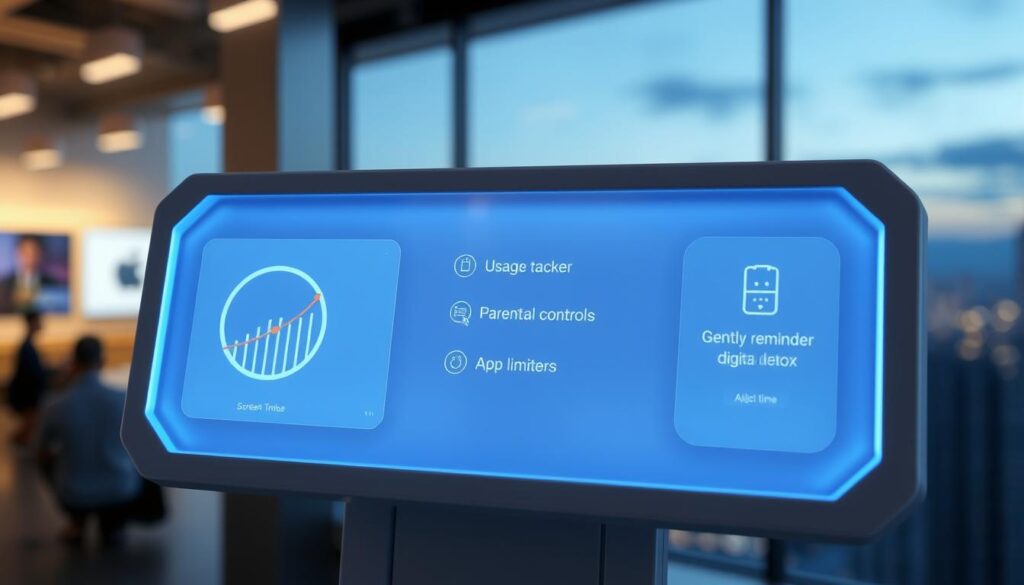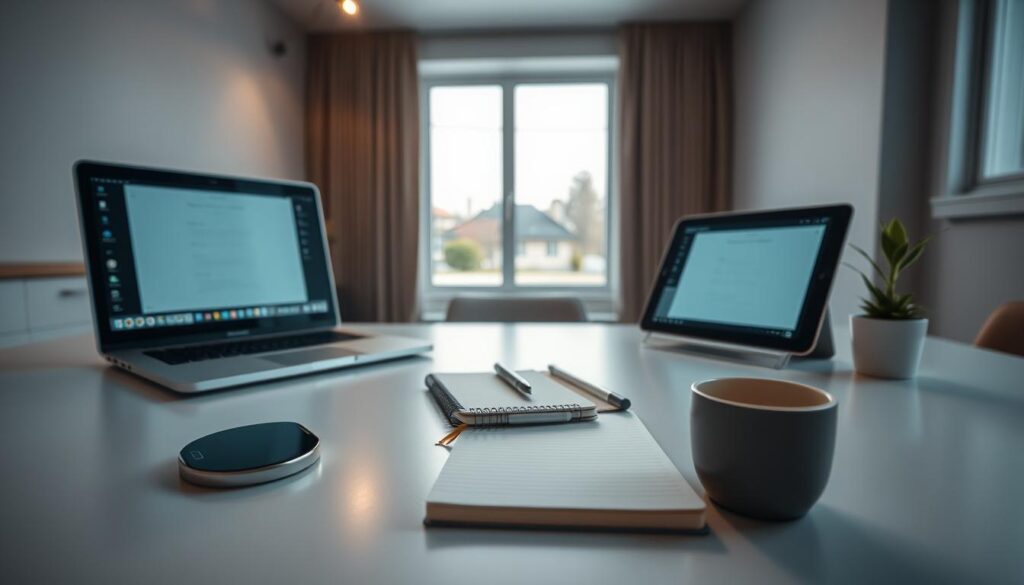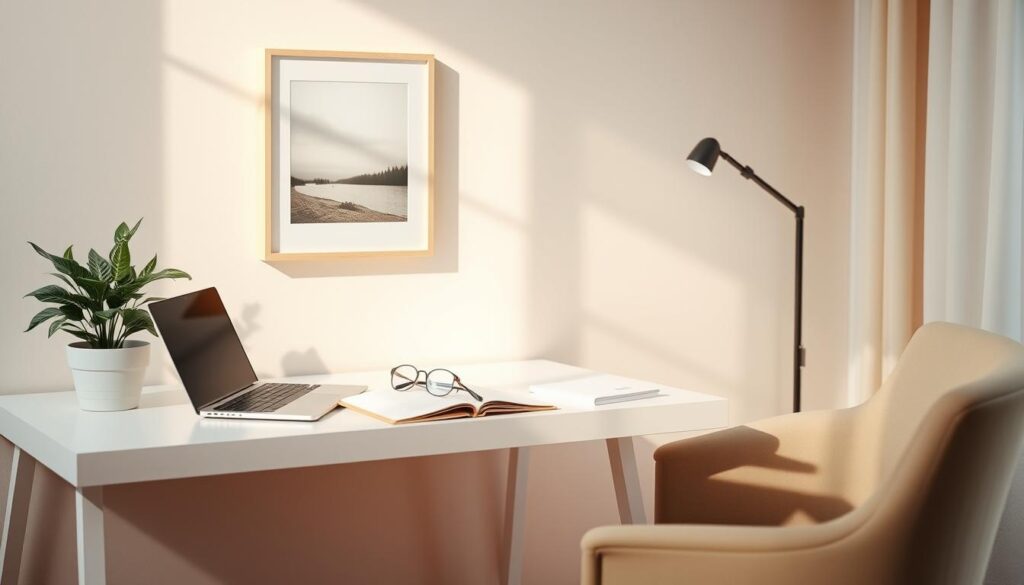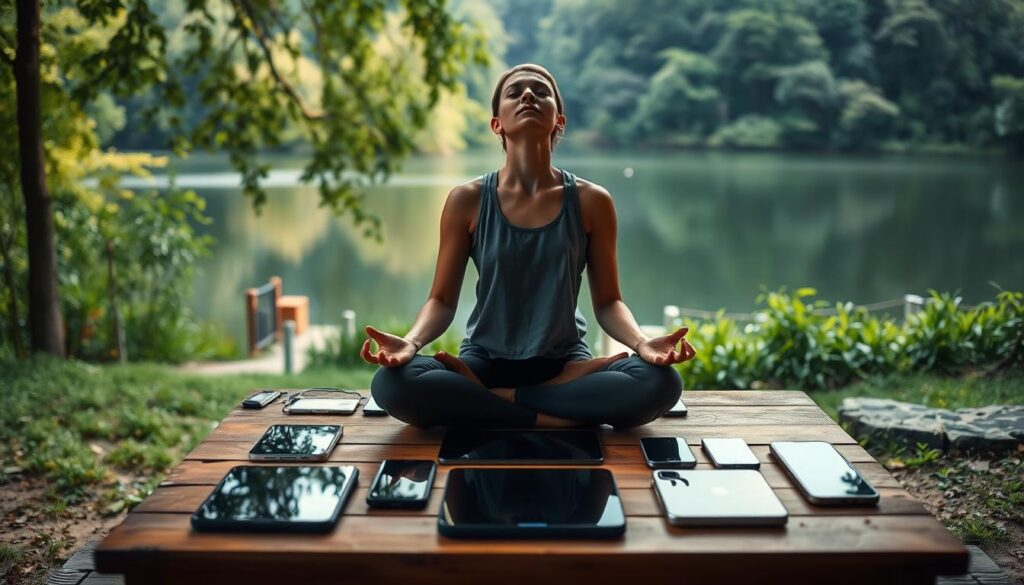We’ve worked hard to create screen time management tips that really help in today’s digital world. These tips are not just effective; they’re also easy to add into our daily lives. They help us keep a healthy balance between our online and offline lives. If you’re trying to use your screen less or just want to keep your digital use healthy, our advice can guide you.
- Key Takeaways
- Understanding the Impact of Excessive Screen Time
- What Constitutes Healthy Screen Time Habits?
- Screen Time Management Tips for Families
- The Role of Technology in Screen Time Management
- Setting Realistic Screen Time Limits
- Strategies for Reducing Screen Time
- The Importance of Digital Detox Strategies
- Encouraging Mindful Technology Use Among Teenagers
- Limiting Screen Time for Kids: Techniques That Work
- Screen Time Management Tips
- Creating a Culture of Digital Wellness at Home
- Conclusion
- Outbound Links
- FAQ
- What are the health effects of excessive screen time?
- How much screen time is recommended for different age groups?
- How can we find a balance between monitoring screen time and using technology mindfully?
- What constitutes healthy screen time habits?
- How can families manage screen time effectively?
- What role do monitoring apps play in managing screen time?
- What are practical tips for setting realistic screen time limits?
- What are some incremental strategies for reducing screen time?
- How can we replace screen time with healthy alternatives?
- How important are digital detox strategies?
- What are the best ways to encourage mindful technology use among teenagers?
- What are age-appropriate screen time guidelines for kids?
- In what ways can parents model effective screen time management?
- Can you offer practical steps to balance digital and real-life activities?
- How can we build a roadmap for reducing screen time?
- What are the components of a healthy digital wellness culture at home?
- What are some technology use guidelines for a healthy lifestyle?
Key Takeaways
- Effective screen time management is essential for a balanced lifestyle.
- Healthy screen habits contribute to overall digital wellness.
- Practical and actionable tips can help mitigate excessive screen use.
- Our approach to screen time can be improved with tailored strategies.
- Implementing these tips can lead to significant improvements in life quality.
- Digital wellness strategies can aid in achieving better sleep and reducing sedentarism.
Understanding the Impact of Excessive Screen Time
Today, we’re all using technology more in our daily lives. It’s key to know how much screen time is too much for our health. This includes understanding its effects on our sleep, physical state, and mental health.
The Health Effects: From Sleep to Sedentary Lifestyles
Being glued to our devices can harm our health in many ways. One major issue is poor sleep caused by screens’ blue light, which messes with our sleep cycles. Sitting too long while on our devices can lead to health problems, like heart disease.
It’s important to keep an eye on these effects and find a happy medium. This way, we can avoid the negative side effects of too much screen time.
Screen Time Among Different Age Groups: Kids to Adults
How much screen time is okay changes with age, from kids to adults. Children need strict screen time limits for healthy growth, as recommended by experts. Adults juggle work and fun on screens, making it hard but crucial to limit screen time.

Monitoring Versus Mindful Use: Finding the Balance
There are two ways to manage our screen time better: monitoring and mindful use. Apps can track how much time we spend on screens. Being mindful makes us think about our technology use more deeply.
Finding the right balance between the two can improve both our personal and work lives.
What Constitutes Healthy Screen Time Habits?
In our digital world, it’s not just about the amount of screen time. It’s about using it wisely. It means making rules for both our digital and real-life health. We aim to create plans that involve setting limits on screen time, having breaks from tech, and making sure screen use is valuable.
We need to think about how screens fit into our lives. Setting screen time limits helps us and our families do more non-digital stuff. This balance is key. Plus, taking breaks from technology, like no devices before sleep, can reset our minds and improve our sleep.
- Avoid using screens during meal times to encourage in-person interactions and mindful eating.
- Create screen-free zones in areas like bedrooms and dining areas to promote better sleep and family interactions.
- Use screens purposefully for work, education, or meaningful social connections rather than passive consumption.
- Engage in regular physical activity to counteract the sedentary nature of prolonged screen use.
- Plan regular technology detox periods to give the mind a break and reduce dependency on digital devices.
Building good screen habits boosts our work and health. Let’s find ways to make technology work for us, not control us. This balance is key to a healthy life with tech.

Screen Time Management Tips for Families
Managing digital device usage in families takes effort. It’s about creating screen time boundaries, rules, and finding other activities. Doing this improves both mental and physical health.
Creating Screen-Free Zones in Your Home
Setting up screen-free zones at home boosts family time and sleep quality. Make the dining room and bedrooms digital-free to enjoy meals and sleep better. Everyone should agree on rules for these zones.
Implementing Screen Time Schedules
Scheduling screen time helps balance our digital and real-world time. Plan hours for study, work, and fun to control screen exposure. Getting kids involved teaches them time management and teamwork.
Encouraging Screen Time Alternatives
It’s important to find activities that replace screen time. Encourage reading, playing outside, crafting, and other hobbies. These activities promote growth and family bonding, away from screens.

The Role of Technology in Screen Time Management
In our digital world, managing screen time is key. It’s important for both our body and mind. Tools like screen time apps and parental controls have changed how we deal with technology. Using them every day can help us manage our devices better and follow rules on tech use.
Using Screen Time Monitoring Apps
Screen time apps are vital for understanding our digital habits. They give us data on how long we’re on our devices and what we’re doing. This info helps us see which apps we use most. It lets us choose to cut down screen time and do other things instead. For example, if we’re spending too much time on social media or games, we can set limits.
Parental Controls and Digital Devices
For families with kids, parental control apps are crucial. They let parents control what their kids see online and how long they’re on devices. Tools like content filters, app blockers, and bedtime settings keep kids’ tech use safe. Parents can use these to make sure tech use fits with family rules.

These tech solutions are more than just tools. They’re our partners in living a healthier digital life. Screen time and parental control apps give us the data and control we need. They help us make smarter choices for us and our families. This leads us to use technology in a more balanced way.
Setting Realistic Screen Time Limits
Setting screen time limits isn’t just about cutting down screen hours. It’s also about finding a healthy digital balance that fits our lives. Whether for work or fun, finding the right balance is key for our mind and body health. Knowing that each person’s digital needs are different is important for a good balance.

For example, people working might need to stay connected for their job. But, limiting screen time for fun can stop digital overload. An adult might try to keep personal screen time under two hours daily. They can fill the rest of their day with exercise, hobbies, and meeting people face-to-face.
To help set achievable screen time goals, here are some smart strategies:
- Make a daily plan that schedules screen use times and includes breaks from screens.
- Use digital tools to track screen time. This shows how much you use screens and helps you improve.
- Set clear rules for screen use. Know what’s necessary and what’s not.
By using these ideas in our daily lives, we promote a healthier approach to using digital devices. We make sure our screen time adds to our lifestyle rather than taking away from it. The aim is to make our lives better with technology, not overwhelmed by it.
Strategies for Reducing Screen Time
In today’s digital age, controlling screen time is more important than ever. We can use the Kaizen approach to limit screen time for small, gradual changes. By making tiny, doable improvements from time to time, we can cut down screen time. This makes reducing screen time doable and long-lasting.
Finding other fun things to do instead of screen time is key. Healthy screen time alternatives help move our focus away from screens. For example, physical activity as a screen time substitute not only cuts down screen time but also helps us stay fit and healthy.
| Current Screen Time | Incremental Reduction Goal | Alternative Activity |
|---|---|---|
| 2 hours daily on social media | Reduce to 1.5 hours over a month | 30 minutes daily walk |
| 1 hour daily gaming | Reduce to 30 minutes over two months | Join a local sports club |
Changing our screen habits means finding new ways to enjoy our free time. Taking up a sport or going out more with friends and family can refresh us. Whether it’s playing sports, crafting, or going to community events, there are plenty of fun and fulfilling options.

Read more: Network Virtualization Indepth Master Guide 2025
Read more: Neuromorphic Computing | How Does It Work?
Read more: How to Set Up a Remote Office on a Budget
The Importance of Digital Detox Strategies
In our world filled with digital devices, digital detox strategies are key. They help us manage our screen time. They also let us take a break from technology to improve our mental wellness. Often, we’re always connected due to smartphones and laptops. This is why taking breaks is crucial.

To start a technology detox, plan times to avoid digital devices. Substitute these times with activities like reading or walking outdoors. Here’s a simple plan to balance your screen time:
- Schedule daily ‘tech-free’ hours, typically during meal times or before bed.
- Plan regular tech-free weekends or holidays to deepen personal connections and relaxation.
- Use device settings to limit notifications and encourage periods of disconnection.
- Engage in hobbies that keep the mind busy without digital help.
Adding these habits to our lives makes technology our ally, not our master. Below is a table showing benefits and ways to detox from technology.
| Benefits of Digital Detox | Method of Implementation |
|---|---|
| Improved mental health and focus | Dedicate specific time slots as digital-free hours. |
| Enhanced personal relationships | Maintain tech-free zones in living and dining areas. |
| Increased productivity | Turn off non-essential notifications during work or creative hours. |
| Better sleep quality | Avoid screens at least an hour before bedtime. |
With screens everywhere in modern life, using digital detox strategies is more important than ever. These strategies help keep our screen time in check. They ensure that our use of technology is both healthy and meaningful.
Encouraging Mindful Technology Use Among Teenagers
To help teenagers use technology mindfully, we must know their digital world and its effects. We want to balance screen time for teens so it doesn’t stop their real-life growth. By using technology use guidelines for teenagers, we guide them towards better habits and productive screen time.
- Starting honest talks about their digital content and its importance.
- Setting fair limits that mix online and offline activities well.
- Promoting physical hobbies that reduce digital device use.
Teaching teens about too much screen time’s effects is crucial. This knowledge leads to a self-managed approach to digital use. It makes them more aware of their online time and its effects.
| Strategy | Description | Expected Benefit |
|---|---|---|
| Discussion and Awareness | Engage in dialogue about digital habits and their consequences. | Increases self-awareness and accountability in digital engagement. |
| Limits and Balance | Implement structured time limits for technology use. | Promotes a healthier daily routine with balanced activities. |
| Hobbies and Activities | Encourage participation in physical and social activities. | Reduces dependency on digital devices for entertainment. |
By promoting these habits, we help teens manage their digital lives wisely. These guidelines reduce the drawbacks of too much screen time. They also boost their well-being and productivity.
Limiting Screen Time for Kids: Techniques That Work
In today’s world, limiting screen time for kids is very important. By setting age-appropriate screen time rules and being good parents as role models, we teach our kids healthy technology habits. These habits will help them for their whole lives.
It’s vital to follow screen time guidelines fit for each age. This ensures screen time helps a child’s growth and happiness.
Age-Appropriate Screen Time Guidelines
- For infants under 18 months, keep screen time to just video chats with family.
- Children aged 18 to 24 months should watch quality shows. And they should do it with someone who can explain it.
- For preschoolers, ages 2 to 5 years, limit non-learning screen time to about an hour on weekdays.
- Older children should cut down on fun screen time. They should also move more and hang out with friends.
Parents as Role Models: Leading by Example
Being a good example with healthy technology habits is key. When kids see their parents as role models limit their screen time, have tech-free meal times, or enjoy physical activities, they tend to do the same.
Helping kids see why it’s important to limit screen time, and showing them how we balance our lives, sets them up for healthier habits. This goes beyond just tech.
Screen Time Management Tips
In our world driven by tech, finding a balance between digital and real-life is key. Let’s talk about how to manage screen time better. We aim to help you keep a balanced digital life.
Practical Steps to Balance Digital and Real-Life Activities
First off, it’s key to set limits on when to use your devices. Pick certain times for using gadgets and stick with them. Alarms can remind you it’s time to pause from screens.
Also, turning off non-essential app notifications can cut distractions. Make sure your daily routine includes fun activities not involving screens. This benefits both your body and mind.
- Establish specific device usage times
- Set alarms for screen breaks
- Turn off unnecessary notifications
- Create a routine favoring non-screen activities
Building a Roadmap for Screen Time Reduction
To reduce screen time, start by tracking how much you currently use your devices. Find out which apps or habits increase your screen time. Setting realistic goals for cutting down is best done slowly, to make it a habit.
Working on this with a friend or family member can boost your success. And, looking into books or online tips on screen time management can offer more help.
- Track current device usage
- Identify high usage apps and behaviors
- Set realistic, incremental reduction goals
- Engage with an accountability partner
- Explore additional resources and strategies
Creating a Culture of Digital Wellness at Home
In this digital era, it’s key to foster digital wellness at home. We know that screen time affects our health. So, a balanced use of technology is part of staying well today. This approach helps us set rules for tech use and build healthy habits with it.
Seeing how screen time and health link up helps shape our daily habits. This focus improves our health and supports a lifestyle we can keep up.
We aim to set clear technology use guidelines. These don’t just cut down screen time. They also promote positive and useful digital device interactions. Below are our main rules for a healthy digital life at home:
- Creating media-free areas to boost family time and self-care.
- Tailoring screen time limits to fit each person’s needs.
- Talking regularly about digital use’s good and bad sides.
- Encouraging activities that get us away from screens and moving, socializing, or being creative.
To keep up with these strategies takes constant work and updates as family and tech change. By sticking to these practices, we make sure digital wellness at home is alive and well.
| Age Group | Recommended Screen Time | Healthy Alternatives |
|---|---|---|
| Children (5-12 years) | 1-2 hours daily | Outdoor play, reading, arts |
| Teenagers (13-18 years) | 2 hours daily | Sports, hobbies, socializing |
| Adults | Flexibly managed | Exercise, cooking, part-time classes |
Through smartly setting up and keeping our technology use guidelines fresh, every family member gets to know their digital usage better. They make smarter choices. This not only lifts digital wellness at home but boosts overall health and happiness, too.
Conclusion
In this article, we looked at the importance of managing screen time and its big role in our digital health. With more technology in every part of life, it’s key to find a healthy balance. This protects us, especially young people, from too much screen time.
We encourage families to try different ways to manage screen time. This includes having areas without screens and using apps to monitor usage. Our goal is to create a place where digital health is top priority. We’re not giving up technology, but using it to improve our lives in every way.
Our aim is to find a healthy balance with screen use. We want to help each other develop good habits for our wellbeing. The strategies we’ve talked about can help us live better with technology. They are just the beginning of creating a balanced digital world.
Outbound Links
-
https://www.commonsensemedia.org – Trusted guidance on screen time by age
-
https://www.cdc.gov/screen-time – CDC’s advice on limiting sedentary behavior
-
https://www.aap.org – American Academy of Pediatrics screen time recommendations
-
https://www.nytimes.com/guides/smarterliving/screen-time-tips – Lifestyle screen time advice
FAQ
What are the health effects of excessive screen time?
How much screen time is recommended for different age groups?
How can we find a balance between monitoring screen time and using technology mindfully?
What constitutes healthy screen time habits?
How can families manage screen time effectively?
What role do monitoring apps play in managing screen time?
What are practical tips for setting realistic screen time limits?
What are some incremental strategies for reducing screen time?
How can we replace screen time with healthy alternatives?
How important are digital detox strategies?
What are the best ways to encourage mindful technology use among teenagers?
What are age-appropriate screen time guidelines for kids?
In what ways can parents model effective screen time management?
Can you offer practical steps to balance digital and real-life activities?
How can we build a roadmap for reducing screen time?
What are the components of a healthy digital wellness culture at home?
What are some technology use guidelines for a healthy lifestyle?
Get in Touch with SJ Articles
Read more: What is Silicon Photonics? : Hitachi High Tech Corporation
Read more: Learn a New Skill Fast with These Bite-Sized Courses
Read more: Tech and Mental Health: Striking the Right Balance for Well-Being


